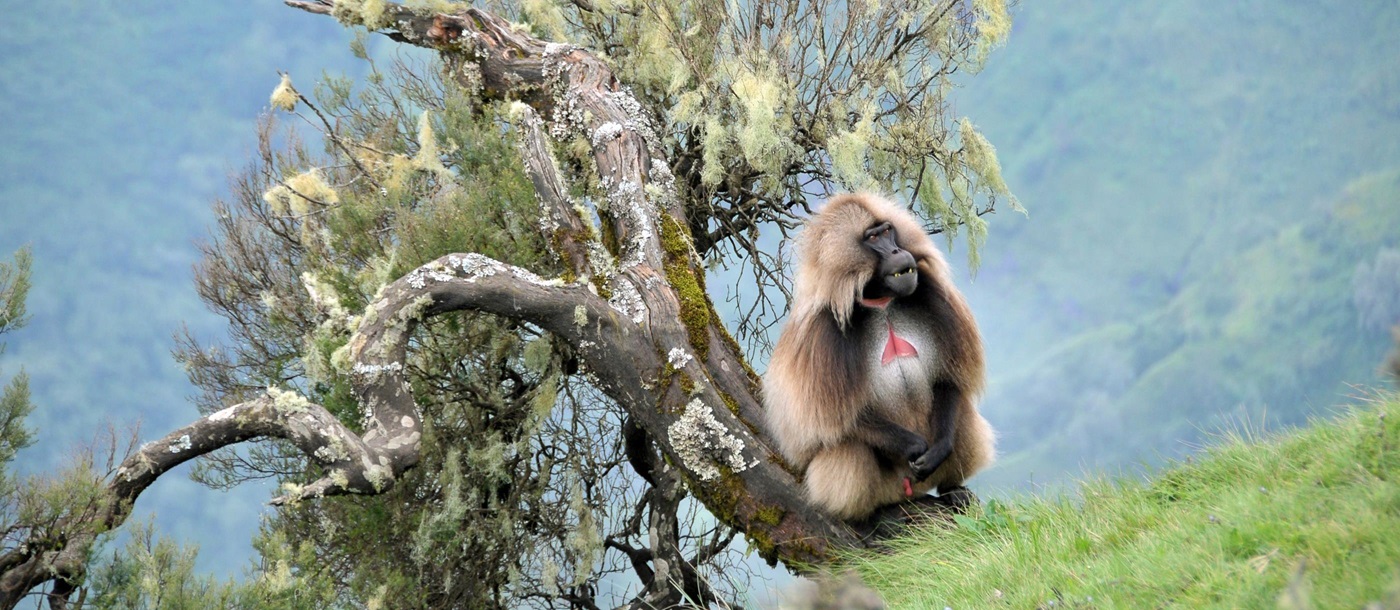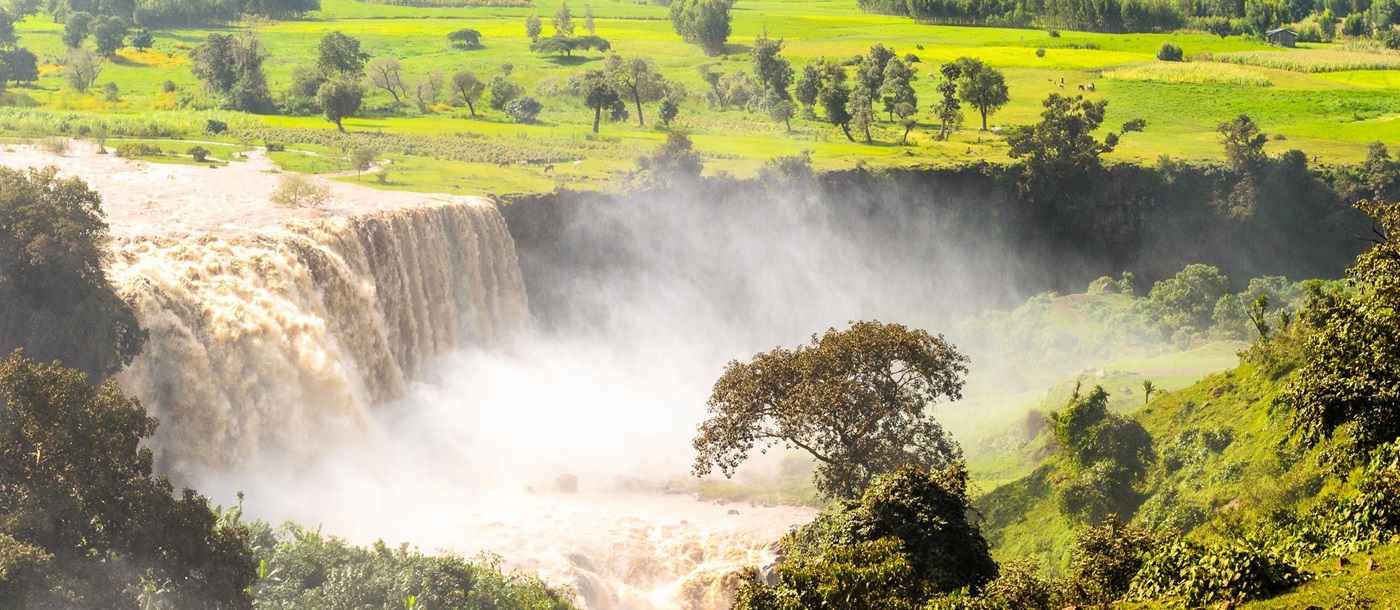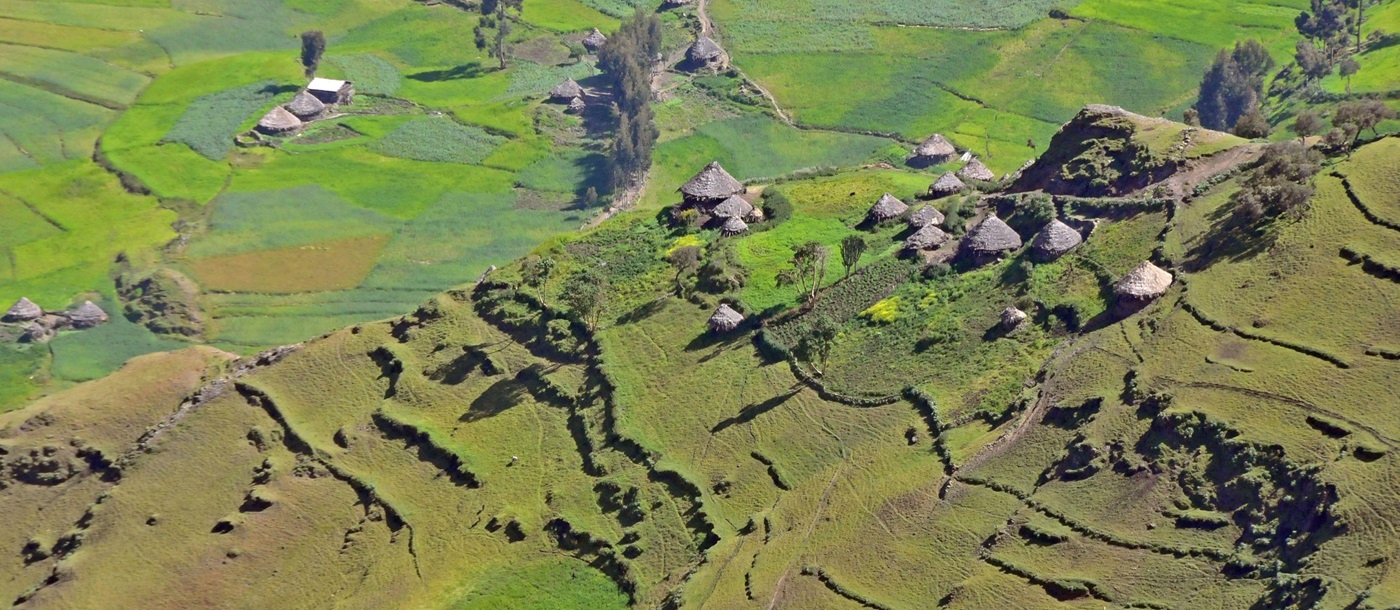Ethiopia's historic north is rich in cultural heritage. Visit the ancient centres of Axum, Gondar, the magnificent complex of Lalibela and the 17th century monasteries of Lake Tana. A visit to the lush panoramas of the Simien Mountains National Park reveals a natural beauty, rich with endemic mammal and birdlife.
THE HISTORIC ROUTE
HIGHLIGHTS
- Visiting the Eighth Wonder of the Ancient World, Lalibela.
- Taking aboat ride on Lake Tana, visiting Ura Kidane Mihret Church.
- Walking in the Simien Mountains.
-
Arrive
-
Day 1 Arrive Addis Ababa
After checking in to your hotel, join your guide to explore Addis Ababa and its environs. Head out to Mount Entoto just to the north of Addis. Emperor Menelik established his permanent camp here, on the site of what is believed to have been the capital of the 16th century monarch Lebna Dengel. At almost 3,000 metres altitude, the site was cold and cultivation difficult and so was abandoned in favour of the plain of Finfine by Empress Taytu in 1889. Two of the original structures of the ancient compound remain: the Churches of Mariam, where Menelik was crowned Emperor, and the octagonal Church of Archangel Raguel. The site offers fine views over the present day capital. The return journey into Addis is broken by a visit to the National Archaeological Museum where exhibits include the 3.5 million-year-old bones of Lucy, through to artefacts from the period of the monarchs Tewodros and Menelik II.
Overnight: Hotel Sheraton
-
Day 2 Addis Ababa - Bahir Dar
Take an early morning flight to the attractive town of Bahir Dar on the banks of Lake Tana, Ethiopia's largest lake and source of the Blue Nile. A morning boat ride will take you to the Zeghie Peninsula, noted for its round, grass-roofed monasteries dating back to the 14th century. Take a walk through the dense forests to visit the two churches of Betra Mariam and Ura Kidane Mehret. The Lake Tana area is where coffee was first cultivated. This afternoon either visit the Blue Nile Falls, some 30 km from the town, or undertake a city tour. The Blue Nile is best visited during and just after the rainy season (June-January) as it cascades some 45 metres over a rock face. Here the Blue Nile, which contributes 85% of the main Nile flow, starts its long journey to the Mediterranean. Outside the rainy season, a visit to the former palace of Emperor Haile Selassie at Bizeit is recommended.
Overnight: Kuriftu Lodge
-
Day 3 Bahir Dar - Gondar
After breakfast set off to Gondar by road. The journey takes approximately three to four hours through attractive scenery and rural villages. Gondar's Royal Enclosure provides a fascinating insight into royal life here during the 17th to 19th centuries, when Gondar served as the imperial capital. The compound envelopes various castles, stables and churches along with a banqueting hall. Just outside the city lies the huge Bath of King Fasilides. At Timkat (Epiphany), the river is diverted here and worshippers plunge in in a re-enactment of Christian baptism. Don't miss the Debre Berhan Selassie Church, a gem of a church which survived the Mahdist invasion of the 1880's. The walls and ceiling are completely covered with murals - the hand-painted angels' faces on the ceiling have become a common motif in Ethiopian design. Continue to the ruined palace of Queen Mentowab and the church of Qusquam Mariam, situated on a hill just outside town. The centre of Gondar is an interesting melange of Gondarine architecture and Art Deco, the latter dating back to Italian occupation between 1936 and 1941, around the central Piazza. Here the tradition of azmari music - a singer and masingo player - is kept alive.
Overnight: Goha Hotel
-
Day 4 Gondar - Simien Mountains
This morning, head north to the Simien Mountains National Park, a UNESCO World Heritage Site. A natural wilderness, the mountains are incised by deep canyons and rivers, eroded over millennia and, as a result, known as 'God's chessboard'. Noted for its endemic species, the Simiens are home to the Gelada or bleeding heart baboon, the Walia Ibex, the Simien Wolf and rock hyrax. The birdlife of Ethiopia is important, with more than 20 endemic species. Found here are the Thick billed Raven, Black headed Siskin, White Collared Pigeon, Wattled Ibis, White billed Starling, Spot breasted Plover and White backed Tit. This afternoon, venture further into the park, past Sankaber, for marvelous views and baboon spotting.
Overnight: Simien Lodge
-
Day 5 Simien Mountains - Gondar
Enjoy sunrise in the Simien Mountains and venture further to enjoy the flora and fauna, as well as the natural landscapes before returning back to Gondar.
Overnight: Goha Hotel
-
Day 6 Gondar - Lalibela
This morning, fly on to Lalibela. Often referred to as the Eighth Wonder of the Ancient World, Lalibela was created at the instruction of King Lalibela of the Zaghwe dynasty in the late 12th, early 13th centuries. The highly unusual complex consists of 11 churches, hewn from the rocks of the earth, all of which are still in use. Your guide will lead you through the labyrinth of passageways and tunnels which connect the churches of Lalibela and explain its construction in the context of its time.
Overnight: Mountain lodge
-
Day 7 Lalibela
This morning choose between a hike or mule ride up to the Church of Ashetun Mariam or a visit by car to the Cave Church of Neakuto Leab. The hike or mule ride takes you through typical rural villages, with excellent views of the surrounding countryside. After lunch set off by car to the Axumite style cave church of Yemrehane Christos.
Overnight: Mountain lodge
-
Day 8 Lalibela - Axum
This morning, take a flight to Axum, the seat of one of the ancient world's four great powers, along with Rome, China and Persia, from 200 AD to 700 AD. During this 'golden age', Axum was a great trading empire, minted its own currency, alphabet and built great engineering works. This afternoon, visit the stelae, the Axum Museum, King Kalab's castle, the Bath of the Queen of Sheba, and the tomb of King Basen, whom Orthodox Ethiopians believe to be one of the three magi who presented gifts to baby Jesus. Proceed to the grounds of Mariamtsion Church. A chapel within the church is believed to house the Ark of the Covenant.
Overnight: Yeha Hotel
-
Day 9 Axum - Yeha - Axum
This morning, take a visit out to Yeha, which dates back some 2800 years, to when Yeha was Ethiopia's first city. There are the remains of a temple dedicated to Ilmuqeh, the moon god, and next to the temple is the church of Abune Aftse, one of the "9 Saints" who did much to spread Christianity in Ethiopia. The temple at Yeha is the oldest building in sub Saharan Africa. Returning to Axum, stop en route for photos at the 'teeth of Adua', a striking panorama and site of the defeat of the Italians by King Menelik II in 1896.
Overnight: Yeha Hotel
-
Day 10 Axum - Addis Ababa - Depart
Transfer to the airport for the return flight to Addis Ababa. There is a choice of visits today. A visit to the Institute of Ethiopian Studies is fascinating, with displays of clothing from different regions, artifacts, household utensils paintings reflecting the history and culture of the country. The building was once the Genete Palace of Emperor Haile Selassie, and visitors can see his bedroom and bathroom. Visit the Giorghis Church, and/or Menelik's Mausoleum, where Etege Taitu and Queen Zauditu are also buried. Alternatively, visit the Mercato, the largest market area in Africa, where virtually every possible commodity is on sale, from livestock to computers. Be prepared to haggle over a huge selection of Ethiopian arts and crafts. Take your return flight home.
-
Depart
GUIDELINE PRICES - Per Person
| Low | $ 5,066 |
| Mid | $ 6,079 |
| High | $ 6,965 |
BOOKING NOTES
- Price is per person, based on two people sharing a room
INCLUSIONS
- All accommodation as detailed in the itinerary.
- Daily breakfast.
- Private transfers throughout.
- All sightseeing, entrance fees and guide services as detailed in the itinerary.
- Internal flights where detailed in the itinerary.
EXTRAS
- International flights.
- Meals not indicated in the itinerary.
- Items of a personal nature such as laundry, drinks, gratuities (discretionary).
- Entrance fees and excursions not specifically mentioned as included.
- Travel insurance or visa fees.

-
REASONS TO BOOK
Award-winning travel specialists with expert knowledge and the best contacts in the business.
READ MORE
















